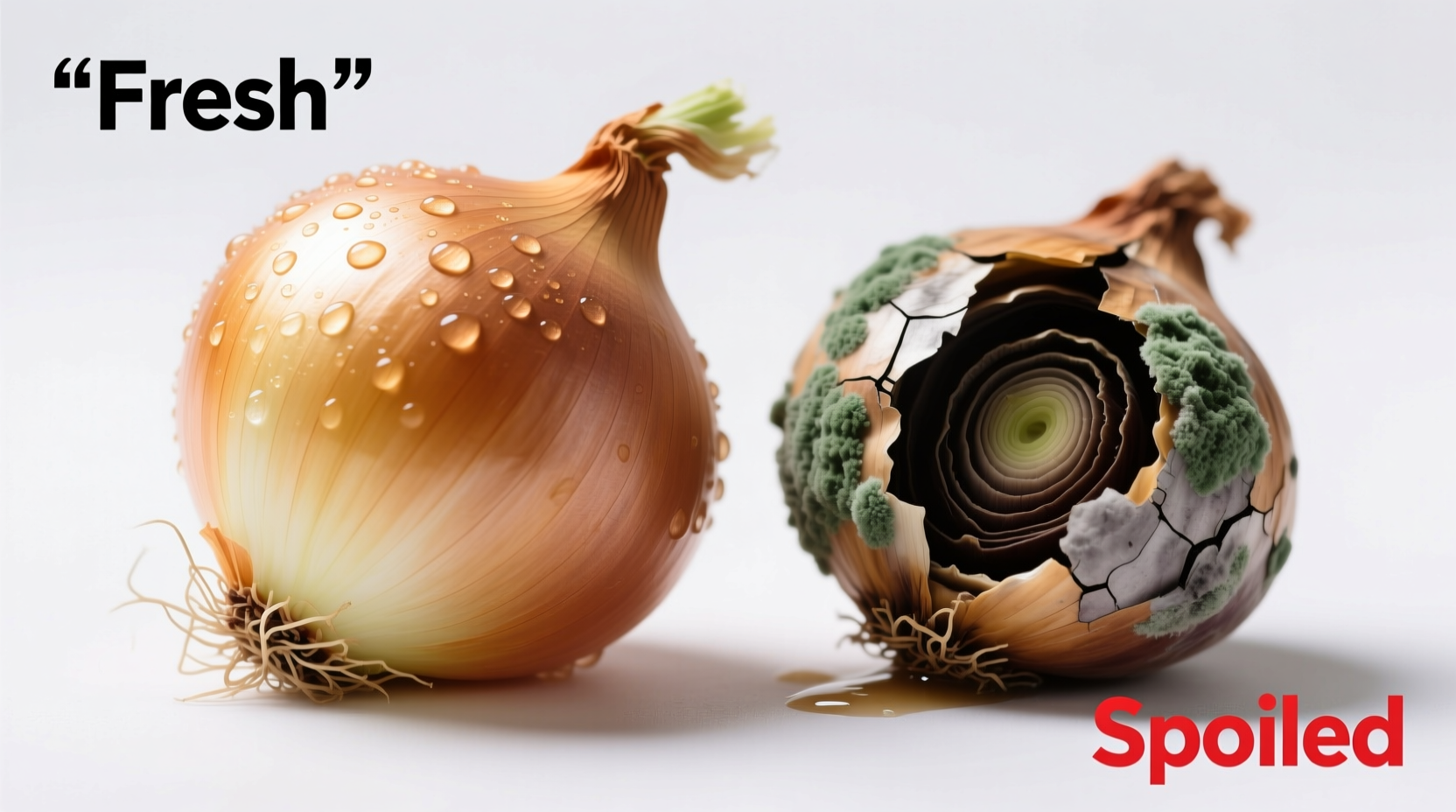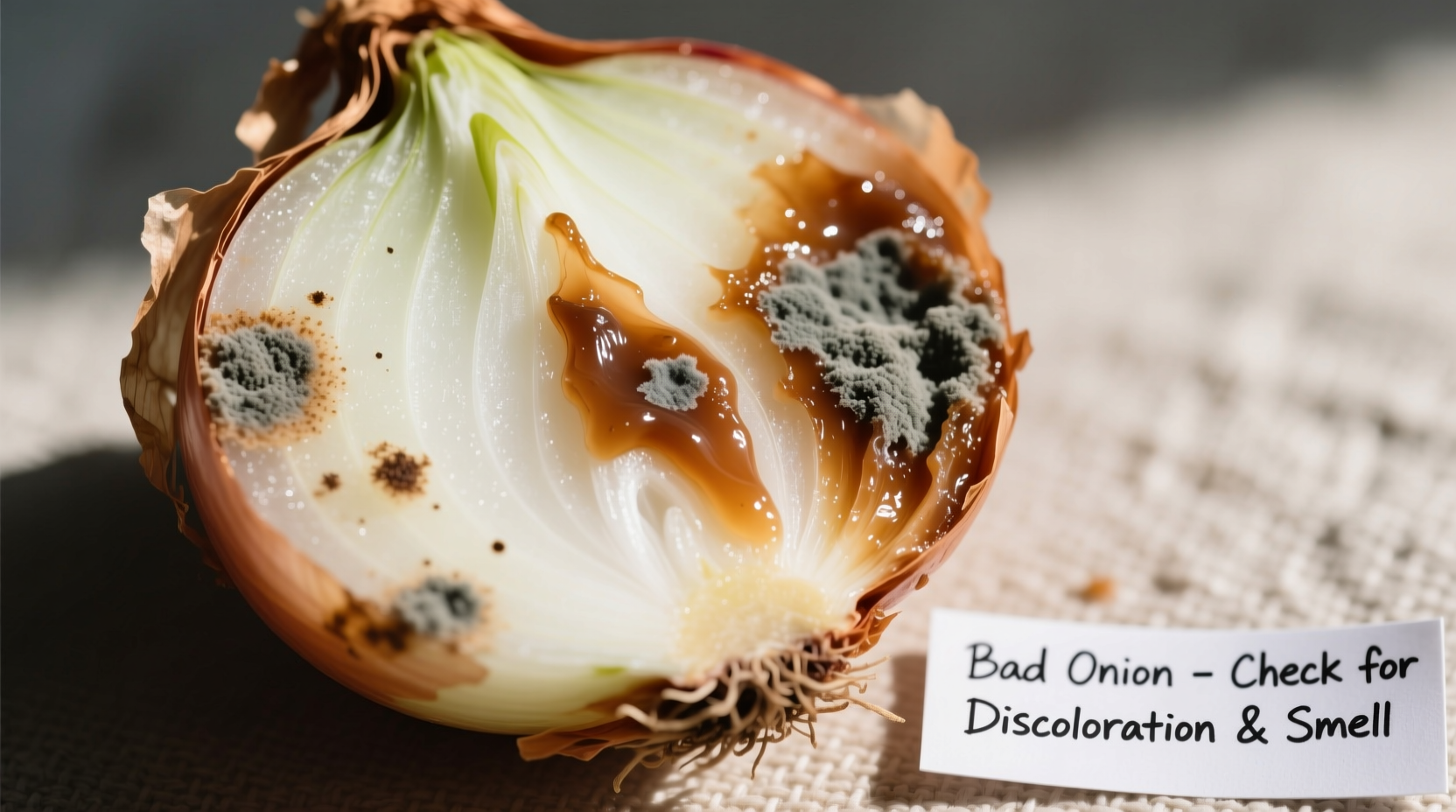Discover exactly how to tell if an onion is bad with these immediate visual, texture, and smell indicators: check for soft spots, mold growth, slimy texture, and unpleasant odors. A spoiled onion often shows dark patches, feels mushy when pressed, and emits a sour or rotten smell instead of its characteristic sharp aroma.
Onions are kitchen staples that can quickly spoil if not stored properly, potentially causing foodborne illness if consumed when rotten. Recognizing the signs of a bad onion isn't just about preventing wasted ingredients—it's crucial for food safety. This guide provides clear, science-backed indicators to help you confidently determine whether that onion in your pantry is still safe to use.
Visual Indicators of Onion Spoilage
Before touching or smelling an onion, your eyes can reveal the first warning signs of spoilage. Fresh onions should have firm, dry outer skins with consistent color depending on the variety. When inspecting onions visually, look for these critical red flags:
- Mold growth - Any fuzzy white, green, or black spots indicate mold penetration
- Dark soft spots - Areas that appear darker and feel soft when gently pressed
- Excessive sprouting - While small sprouts might be acceptable, extensive green growth signals advanced aging
- Wet patches - Moist areas on the skin often precede full spoilage
- Discoloration - Yellowing or browning beyond the normal outer layers
According to USDA food safety guidelines, any visible mold on produce means the entire item should be discarded, as mold roots can penetrate deeper than what's visible to the naked eye.
| Condition | Good Onion | Bad Onion |
|---|---|---|
| Outer Skin | Dry, papery, intact | Damp, slimy, or moldy |
| Color | Bright, consistent for variety | Dark spots, yellowing, or browning |
| Texture | Firm throughout | Soft spots or mushy areas |
| Smell | Sharp, characteristic onion scent | Sour, rotten, or unpleasant odor |
Tactile Indicators: What a Bad Onion Feels Like
Your sense of touch provides crucial information about onion quality. Properly stored onions should feel solid and heavy for their size. When evaluating texture:
- Gently squeeze the onion—any give or softness indicates internal decay
- Check for slimy or sticky surfaces, which signal bacterial growth
- Notice if the onion feels unusually light, which suggests internal drying or rot
- Examine the root end for excessive moisture or mushiness
Food science research from the FDA shows that texture changes often precede visible spoilage by several days. When an onion loses its firmness, it's entering the early stages of decomposition that can harbor harmful bacteria.
Olfactory Indicators: Smelling for Spoilage
Your nose is one of the most reliable tools for detecting spoiled onions. While all onions have a distinctive aroma, a bad onion produces noticeably different odors:
- Sour smell - Indicates bacterial fermentation
- Rotten odor - Signals advanced decomposition
- Musty scent - Often accompanies mold growth
- Complete absence of odor - Can indicate internal rot where the onion has lost its volatile compounds
Unlike some vegetables that develop only slightly off smells when beginning to spoil, onions have such a strong natural aroma that any deviation is usually quite noticeable. If your onion smells unpleasant or different from its usual sharp scent, it's time to discard it.

Onion Spoilage Timeline: What Happens as Onions Go Bad
Understanding the progression of onion spoilage helps catch problems early. Here's the typical timeline from fresh to spoiled:
- Days 1-7: Optimal condition with firm texture and strong aroma
- Days 8-14: Outer layers may dry further; minor sprouting might begin
- Days 15-21: First signs of soft spots; slight odor changes possible
- Days 22-28: Visible dark spots; texture becomes inconsistent
- Day 29+: Significant mold growth; slimy texture; strong unpleasant odor
This timeline varies based on storage conditions, with refrigeration extending freshness for cut onions but potentially reducing shelf life for whole onions due to moisture exposure.
Storage Conditions That Prevent Onion Spoilage
Proper storage dramatically extends onion freshness. Follow these evidence-based storage recommendations from food safety experts:
- Store whole onions in a cool, dark, well-ventilated area (not the refrigerator)
- Maintain temperatures between 45-55°F (7-13°C) for optimal longevity
- Keep away from potatoes, which emit moisture and gases that accelerate onion spoilage
- Never store onions in plastic bags, which trap moisture and promote rot
- For cut onions, refrigerate in airtight containers and use within 7-10 days
Research from the National Onion Association shows that proper storage can extend onion shelf life by up to 50% compared to improper storage methods. The key is maintaining dry conditions with adequate airflow.
Food Safety Risks of Consuming Bad Onions
Eating spoiled onions isn't just unpleasant—it can pose real health risks. When onions spoil, they can harbor:
- Salmonella - Particularly dangerous as onions provide an ideal growth medium
- Listeria - Can grow even in refrigerated conditions
- Mold toxins - Some molds produce harmful mycotoxins that survive cooking
- Bacterial pathogens - That cause food poisoning symptoms
The Centers for Disease Control and Prevention (CDC) reports numerous foodborne illness outbreaks linked to contaminated onions in recent years. When in doubt about an onion's condition, follow the food safety principle: "When uncertain, throw it out."
Special Considerations for Different Onion Types
Not all onions spoil in exactly the same way. Be aware of these variety-specific considerations:
- Yellow onions - Most common variety; develop dark spots when spoiling
- Red onions - May show purple discoloration beyond normal color when bad
- White onions - Often spoil faster; watch for yellowing
- Shallots - Smaller size means spoilage happens more quickly
- Green onions/scallions - Spoilage first appears at the white root end
Understanding these differences helps you accurately assess each onion variety. For example, slight sprouting in yellow onions might still be acceptable if the bulb remains firm, while the same condition in green onions often indicates advanced spoilage.
When Slightly Imperfect Onions Are Still Usable
Not every imperfection means your onion must be discarded. You can often salvage onions with:
- Minor dry outer layers (simply peel them away)
- Small sprouts (cut out the sprouted section)
- Very minor soft spots (cut away at least 1 inch around the affected area)
- Slight discoloration that doesn't penetrate deeply
The key is assessing whether the spoilage has penetrated deeply into the onion. Surface issues can often be trimmed away, but internal spoilage means the entire onion should be discarded due to potential bacterial contamination throughout.











 浙公网安备
33010002000092号
浙公网安备
33010002000092号 浙B2-20120091-4
浙B2-20120091-4